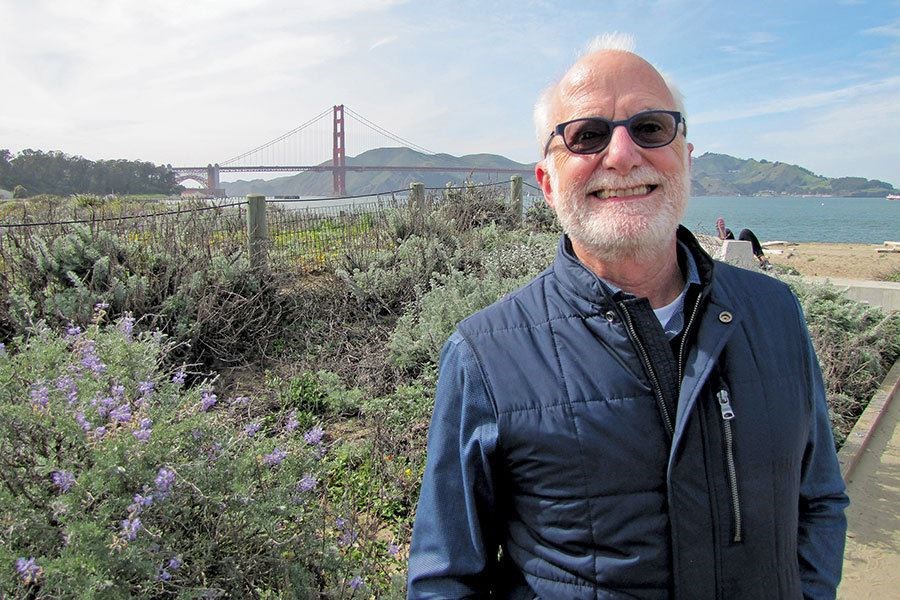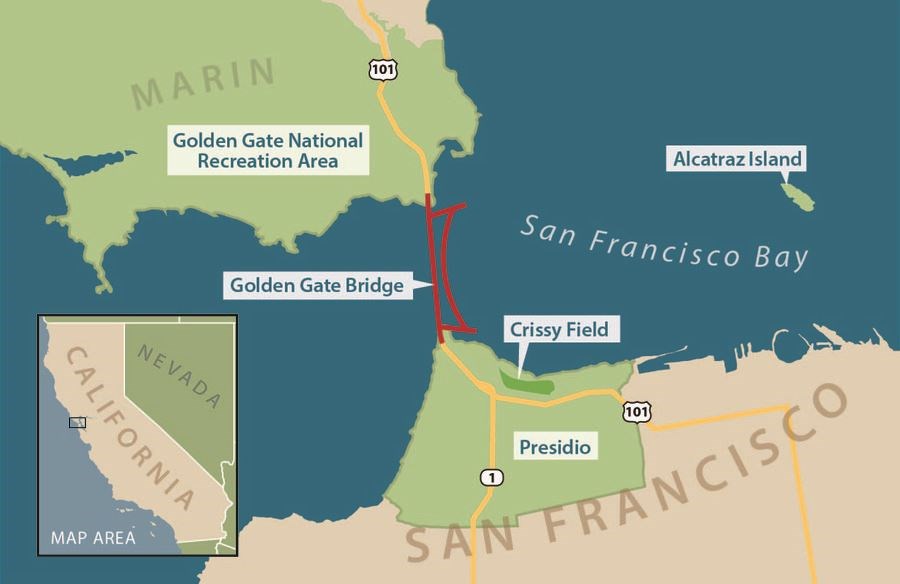Reprinted with permission from The Christian Science Monitor
National parks wouldn’t be the same without the help of partner organizations. One of the most exemplary such groups is in the San Francisco Bay Area, led by Greg Moore.
AUGUST 6, 2018 - SAN FRANCISCO - Greg Moore takes a late-afternoon stroll in San Francisco’s Crissy Field. Families are enjoying the beachfront space, joggers are taking advantage of prime running weather, and other park guests are documenting their adventures with photos.
 Greg Moore of the Golden Gate National Parks Conservancy stands in San Francisco’s Crissy Field, with the Golden Gate Bridge in the background.David KarasIt hasn’t always been like this. The site used to be a grand prix racetrack and later a military airfield, leaving behind a wasteland of pavement and debris. But thanks to some $34.4 million in contributions, the efforts of more than 3,000 volunteers, and three years of leadership by Mr. Moore and his nonprofit organization, the space now stands as a treasured component of the national parklands abutting downtown San Francisco.
Greg Moore of the Golden Gate National Parks Conservancy stands in San Francisco’s Crissy Field, with the Golden Gate Bridge in the background.David KarasIt hasn’t always been like this. The site used to be a grand prix racetrack and later a military airfield, leaving behind a wasteland of pavement and debris. But thanks to some $34.4 million in contributions, the efforts of more than 3,000 volunteers, and three years of leadership by Mr. Moore and his nonprofit organization, the space now stands as a treasured component of the national parklands abutting downtown San Francisco.
“Crissy Field was basically covered with asphalt, chain-link fence, rubble on the shore, and toxic contaminants,” says Moore, who has been at the helm of the Golden Gate National Parks Conservancy for more than 33 years. “[We] turned it into the front yard of our city instead of the backyard of a military post.”
The transformation of Crissy Field is just one example of the effect the conservancy has had on sites within the Golden Gate National Recreation Area since the nonprofit’s establishment in 1981. The group is regarded as one of the most successful partner organizations of the National Park Service, garnering more than $500 million in support for the various sites in and around the San Francisco Bay Area. And according to the NPS, the Golden Gate National Recreation Area consistently ranks as either the first- or second-most-visited park system in the United States, totaling about 15 million visits in 2017.
“Our park is a vacation destination for many people,” says Moore, who is the conservancy’s president and chief executive officer. “But for a large number of people, it’s a part of their everyday life. I think we have the unique opportunity to create a relationship with so many people who see this park making their everyday life richer and better.”
Moore began his career working for the NPS as a park ranger, landscape architect, and environmental planner. He left the park service to attend graduate school for environmental planning and urban studies and then became the conservancy’s first executive director in 1985.
 Golden Gate National Recreation AreaKaren Norris/StaffDuring his tenure, the nonprofit has undergone a revolutionary expansion. “We have grown from four staff to about 350 to 400 staff,” he says, and the organization is managing some 25,000 volunteers annually. Also, in its first year the conservancy provided roughly $9,000 to support the park system, Moore says, but “now we are averaging nearly $40 million a year.”
Golden Gate National Recreation AreaKaren Norris/StaffDuring his tenure, the nonprofit has undergone a revolutionary expansion. “We have grown from four staff to about 350 to 400 staff,” he says, and the organization is managing some 25,000 volunteers annually. Also, in its first year the conservancy provided roughly $9,000 to support the park system, Moore says, but “now we are averaging nearly $40 million a year.”
Early next year, Moore will transition from his longtime leadership post to the role of special projects adviser, through which he will continue to work on key projects.
The effect the conservancy has had could be witnessed on a recent morning on Alcatraz Island, the legendary onetime federal penitentiary that’s popular among visitors. Conservancy volunteers were greeting and directing guests about the island, providing special tours, and working with the garden program to highlight the vast range of plants growing there. The nonprofit also created the award-winning audio tour featuring former inmates and guards.
Beyond physical enhancements to the parklands, Moore’s organization has also worked to ensure the park system is welcoming to all segments of the community and that the sites are relevant to what the community needs. Whether that involves partnering with a veterans hospital to provide guided excursions or working with libraries and schools to bring children to the sites, Moore is passionate about inclusion.
“Having a national park within a major metropolitan area gave us a certain kind of magic to work with,” he says. “Not only did we have these places that were so needed by our urban community, but we had people surrounding these parks who would learn to love them, care for them, and devote their time and attention back.”
Michele Gee, who used to work for the conservancy, now serves as chief of interpretation and education for the Golden Gate National Recreation Area. The conservancy’s effect on the park system, she says, is nothing short of extraordinary.
“Without the Parks Conservancy we might never have restored Crissy Field, built the Lands End Lookout or Presidio Visitor Center, created new overlooks in the Marin Headlands, brought hundreds of schools out to the Muir Woods, and engaged thousands of volunteers and interns in the park,” Ms. Gee says in an email interview. “The Parks Conservancy brings the spirit, vibrancy and unique resources of the Bay Area to our national parks.”
She credits the conservancy not only with shepherding large investments into park projects, but also with helping to modernize the park system and its resources for visitors.
“National parks need a lot of support from organizations like the Parks Conservancy,” she says. “Their ability to fundraise and raise the profile of parks in the Bay Area is invaluable ... [and] as a federal agency [the NPS] we appreciate the flexibility, nimbleness and innovation they provide.”
Gee also speaks highly of Moore and the pivotal role he has played.
“He not only inspires his staff but inspires the community to steward and protect their lands,” she says. “I have worked for or with Greg for over 18 years and in that time I have come to utterly admire his grace, passion and amazing leadership style. He is an indelible part of the parks and this community.”
The philanthropic support that the conservancy has mobilized, Moore says, can do everything from assist in making physical improvements to provide “the room and the resources to dream” about wide-scale enhancements.
One of the new dreams that the conservancy is working toward is the Tunnel Tops parkland in the Presidio. It’s a $90 million project, slated to open in 2021, that Moore will continue to work on in his new role. The project is developing the land above the Presidio Parkway tunnels that lead to the Golden Gate Bridge to include an 11-acre landscape, a three-acre youth campus, and a new visitor center plaza.
Moore credits the S. D. Bechtel, Jr. Foundation with providing a $25 million gift to support the project.
“The Conservancy has been one of the Foundation’s strongest local partners over the last twenty years as they continue to activate new areas of the Golden Gate National Parks through capital improvements and award winning programs, and offer innovative models for conservation of public lands,” says Lauren Dachs, president of the foundation, in an email.
Ms. Dachs commends Moore for his leadership as well as his ability to establish a vision and execute it. “Greg has been a terrific partner for our Foundation in that he understands the various stakeholders needed to have a successful Conservancy which in turn results in real impact,” she says.
Although a lot about the park sites has been transformed during Moore’s tenure at the conservancy, what has remained consistent is his passion for parks.
“I believe these American places, owned by all of us, just have so much to offer. The benefits are so varied and so proven over time, all the way back to 100 years ago when our National Park Service was first founded,” he says. “And each generation appears to take advantage of the benefits that have been proven and show their durability, but then even acknowledging there are increasing benefits that are coming our way.”
And whether it is parents bringing their children to the park sites, tourists learning about the history of Alcatraz, or visitors putting native plants in the ground, those basic interactions with the parklands are what inspire Moore to continue his work.
“What drives me is just visibly, tangibly seeing the benefit of this park in so many different ways,” he says.
• For more, visit parksconservancy.org.
Page created on 8/8/2018 12:45:45 AM
Last edited 8/8/2018 1:07:42 AM
